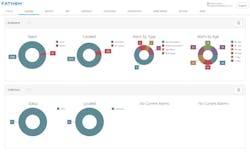Big Data, Big Benefits
Building Resilience with the Smart Grid for Water
Resource scarcity, outdated processes and increasingly savvy customers are creating the perfect storm for water utilities. Like other major industries before them, it’s time for water utilities to harness the power of big data.
By Trevor Hill
To the average Joe, water utilities and their operations are largely a mystery. Given the vital service they provide and the general reliability of their operations, it’s not difficult to envision utilities as large entities with cutting-edge technologies and data-rich systems at their fingertips.
Pieces of the Puzzle: Our Tiny, Fragmented Water Utilities
But in truth, according to the Environmental Protection Agency, over 99 percent of the more than 56,000 community water systems in the United States are hyper-local organizations serving 50,000 people or fewer. With limited technology and financial resources available, the vast majority of utilities are still getting by on the manual, pencil-and-paper operations of yesteryear. These antiquated processes are not only labor intensive but also make it difficult to share data - internally and externally - in a meaningful way. Today, while utilities’ primary goal remains the same as ever - delivering safe, reliable water to customers - it is quickly becoming clear that “business as usual” will no longer cut it.
The water industry is facing challenges on an unprecedented scale. Our water supplies are increasingly more volatile; our water infrastructure is increasingly failing; and conservation - both mandatory and voluntary - is driving revenue down. In fact, reports indicate that a staggering 30 percent of utilities are seeing their year-over-year revenues fall due to a combination of conservation mandates, customers’ voluntary efforts to reduce consumption and the overall increases in efficiency of our water-using equipment. Furthermore, in our increasingly IoT-driven world, customers are demanding more information, simpler engagement and greater transparency from their service providers. For utilities whose business models haven’t changed much over the decades, and whose revenues are on the decline, this shift is seemingly coming too fast and furious to keep up.
The question then becomes: How do we modernize our operations, services and business models to meet the water demands - physical and commercial - of the 21st century to ensure the sustained resilience of our water systems? The answer lies in leveraging integrated data systems to build the smart grid for water.
What is the Smart Grid for Water?
The smart grid for water brings data, analytics, insight and presentment to the water industry. With the tools of the smart grid for water, utilities can better understand how, where and when water is used while at the same time optimizing their business operations.
Here, we will examine how the smart grid for water tackles three major pain points for utilities, adding value along every operational channel and building stronger, smarter water systems.
Metering
A typical water utility collects customers’ meter data on a monthly basis. Not surprisingly, this infrequent interaction makes it challenging for utilities to efficiently monitor their meter population and quickly identify faulty units. Statistical models can point managers in the right direction but not with the precision and speed necessary. With no reliable real-time performance metrics available, meters degrade unannounced - and water and revenue slip away. Over time, these faulty meters can drive utilities to increase rates to compensate for unmeasured water or to send staff searching for phantom leaks in the distribution system that are, in reality, data leaks in the office.
Analytics using big data from multiple sources can protect vital utility revenue by identifying faulty meters in real time before they become major headaches. By combining GIS, CIS, tax parcel IDs, aerial and satellite images, and other locally available information, smart grid for water analytics are able to identify meters missing from a utility’s billing system and quickly alert managers about the issue. In addition, when combined with advanced metering infrastructure data, predictive failure analytics can find meters prior to failure. This continuous meter monitoring enables utilities to wring every last drop out of their supply, infrastructure and revenue.
Employing smart grid for water revenue assurance analytics means that utilities can support conservation measures without compromising business security.
Billing
Although smart water meter solutions are available, adoption has been limited due to infrastructure costs, as well as the lack of systems that can surface the entire value proposition suite. This means the majority of utilities still log meter data manually. Combined with other inefficiencies in billing, collections, remittance management and customer service, the typical water utility spends more than 10 times that of other industries, like telecommunications, to manage the bill-pay process.
For cash-strapped water utilities, minimizing the costs associated with billing and collections is an imperative while maximizing the ability for customers to self-serve can result in immediate benefits. Cloud-based software-as-a-service (SaaS) platforms offer this opportunity at reduced cost and reduced risk. Without hardware installation and oftentimes without cumbersome IT integrations, SaaS systems offer a capital-light back office and data management system that modernizes and standardizes processes while improving the user experience. In addition to streamlining operations, moving to a cloud-based platform also enables utilities to offer their customers significantly enhanced services and notifications.
Efficiency
From monitoring cell phone data usage to noting how many steps they’ve taken over the course of a day, customers are increasingly hungry for actionable information that helps them fine-tune their behaviors. As the planet grows thirstier, accessing water usage data has never been more important. With the tools of the smart grid for water, customers are given access to an intuitive online platform that allows them to connect their daily activities with consumption metrics. The ability to provide customers with highly granular, near real-time data, along with push notifications based on usage and costs, empowers utility customers like never before and makes them better informed participants in the conservation conversation. Bridging the trust gap between utilities and their customers while promoting sustainable use of our most precious natural resource is a huge win-win.
Creating Waves of Change
Big data systems have significantly improved environmental and economic conditions for both utilities and their customers. For example, water managers in the City of Grass Valley, Calif., looked to leading SaaS provider FATHOM to help optimize local operations. On average, utilities harnessing the power of data with support from platforms like these have seen revenue increases of 5 to 15 percent while supporting customer demand reductions in the order of 10 percent. Modernization of processes and increasing channel shift opportunities for customers can significantly accelerate the payment cycle while reducing bad debt by 60 percent.
Our new water reality is placing increased pressure on our utilities to do more with less - less water, less revenue and less resources. The smart grid for water allows utilities to meet this evolving mandate. As big data systems expand in scope and scale globally, the reservoir of data from which we can pull insights will only become richer and enable more precise resource management. With the smart grid for water, utilities can increase revenue, decrease costs and delight customers, now and for generations to come.
About the Author: Trevor Hill is the chairman and CEO of FATHOM, a leading software-as-a-service provider for water utilities, and has over 25 years’ experience in building and leading water companies. Hill co-founded Global Water Resources, an investor-owned utility in the water-scarce southwest United States that, through his leadership and direction, built FATHOM, a suite of software products that provides state-of-the-art back office services to municipal water utilities.


